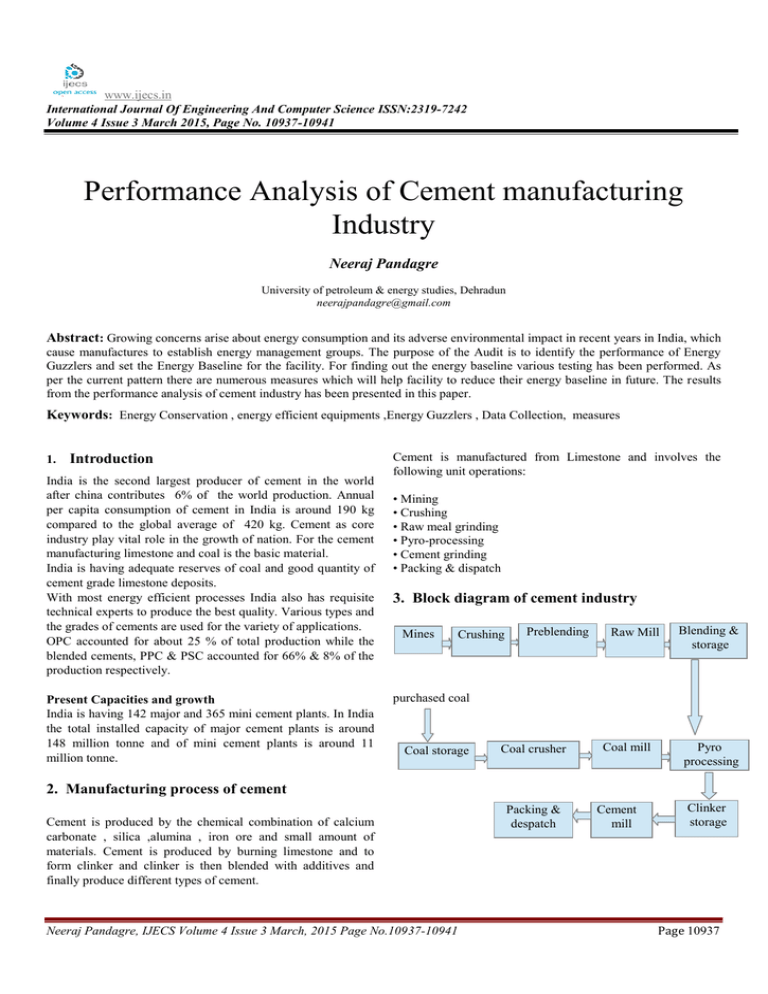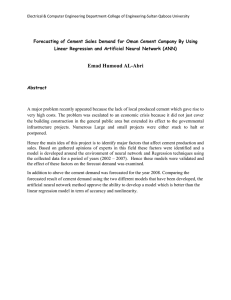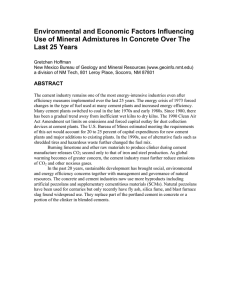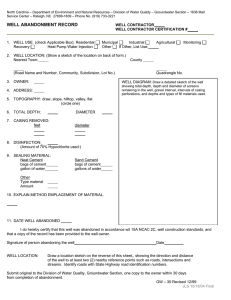www.ijecs.in International Journal Of Engineering And Computer Science ISSN:2319-7242
advertisement

www.ijecs.in International Journal Of Engineering And Computer Science ISSN:2319-7242 Volume 4 Issue 3 March 2015, Page No. 10937-10941 Performance Analysis of Cement manufacturing Industry Neeraj Pandagre University of petroleum & energy studies, Dehradun neerajpandagre@gmail.com Abstract: Growing concerns arise about energy consumption and its adverse environmental impact in recent years in India, which cause manufactures to establish energy management groups. The purpose of the Audit is to identify the performance of Energy Guzzlers and set the Energy Baseline for the facility. For finding out the energy baseline various testing has been performed. As per the current pattern there are numerous measures which will help facility to reduce their energy baseline in future. The results from the performance analysis of cement industry has been presented in this paper. Keywords: Energy Conservation , energy efficient equipments ,Energy Guzzlers , Data Collection, measures 1. Introduction India is the second largest producer of cement in the world after china contributes 6% of the world production. Annual per capita consumption of cement in India is around 190 kg compared to the global average of 420 kg. Cement as core industry play vital role in the growth of nation. For the cement manufacturing limestone and coal is the basic material. India is having adequate reserves of coal and good quantity of cement grade limestone deposits. With most energy efficient processes India also has requisite technical experts to produce the best quality. Various types and the grades of cements are used for the variety of applications. OPC accounted for about 25 % of total production while the blended cements, PPC & PSC accounted for 66% & 8% of the production respectively. Present Capacities and growth India is having 142 major and 365 mini cement plants. In India the total installed capacity of major cement plants is around 148 million tonne and of mini cement plants is around 11 million tonne. Cement is manufactured from Limestone and involves the following unit operations: • Mining • Crushing • Raw meal grinding • Pyro-processing • Cement grinding • Packing & dispatch 3. Block diagram of cement industry Mines Crushing Preblending Raw Mill Blending & storage purchased coal Coal storage Coal crusher Coal mill Pyro processing 2. Manufacturing process of cement Cement is produced by the chemical combination of calcium carbonate , silica ,alumina , iron ore and small amount of materials. Cement is produced by burning limestone and to form clinker and clinker is then blended with additives and finally produce different types of cement. Neeraj Pandagre, IJECS Volume 4 Issue 3 March, 2015 Page No.10937-10941 Packing & despatch Cement mill Clinker storage Page 10937 4. Clinker production process technology The most energy intensive step is the production of cement which accounts for more than 80 % of energy used in the cement production. Production of calciner require three process : • Dry process ~ 96% of the production • Semi-Dry process ~ 2% of the production • Wet process ~ 2% of the production. The cement industry today comprises of Dry precalciner plants and Dry suspension preheater and few semi dry and wet process plants. Today there are 180 kilns in operation out of which 146 are based on dry process , 26 on wet process and 8 on semi dry process. cost of cement manufacturing results in maximization of operational efficiency. Following are the major factors identified for higher energy consumption are • High preheater exit gas temperature (30-55 deg C higher) • High preheater exit gas volume (0.2-0.5 NM3/kg cl. higher) • High pressure drop across preheater (upto 250 mmWG higher) • High moisture in fine coal (upto 6.2%) • Incomplete combustion of coal (CO - upto 1750 ppm) • False air infiltration in kiln and mill circuits (upto 25%) • Low heat recuperation efficiency of grate cooler (50-65%) • High cooler air exhaust temperature (upto 120 deg C higher) • High clinker temperature (upto 180 deg C against 95-100 deg C) • Low efficiency of major process & cooler fans (<60%) Basic principle of precalciner kiln is shown in figure a) : Installation of Highly efficient Dynamic Separator for Raw Mill Brief A new cage type dynamic high efficiency separator replace with the existing static separator in a million tonne dry process pre-calciner plant . Results after installation can be identified with reduction in the specific power consumption of the Mill, the output of the Mill and finer product . The Power Saving amounted to 2.6 units/tonne of Raw meal or 3.1 units/tonne of cement Energy Saving • Horizontal roller mills used for raw material and cement grinding process. • Use of advanced computerized kiln control system which based on artificial intelligence. 5. Need of future modernization of Indian cement industry There are some areas which require further improvements although the industry has energy efficient equipments. • Pre-blending facilities for raw materials. • Fully monitoring facilities and automatic process control. • Co-processing technologies for use of hazardous and non hazardous wastes from the plant. • Standard software expert packages for process and operation control with technical consultancy back-up • Energy efficient equipment for auxiliary/minor operations • Pneumatic cement transportation and Bulk loading . • Low NO /SO combustion systems . • Co-generation of power through cost-effective waste heat recovery system implementation. 6. Energy Efficient measures adopted Annual Energy saving : Rs 2.5 Million KWh Annual Savings : Rs 320 Million Investment : Rs 360 Million Simple payback : 15 months b): Electrical Energy saving by increasing Kiln String Cyclone Brief parameters Before After Implementation Implementati on Saving Cyclone dia 5.5 6.7 Pressure drop 115 85 -30 Energy consumption 752 725 -27 Kiln output 6282 6598 +316 The energy efficiency have been achieved by Indian cement plants at high level , with increase in the competitiveness and Neeraj Pandagre, IJECS Volume 4 Issue 3 March, 2015 Page No.10937-10941 Page 10938 Energy Saving Brief Suppose that there are 3 raw mills, out of which 2 to 3 are in normal operation. There are two slurry pumps of different capacities to meet the carrying capacity requirements. Limestone slurry from the raw-mill section is pumped to the low-grade silos. Energy Savings : 33 kWh Annual Savings : Rs 0.88 Million Investment : Rs 2.8 Million Payback period : 3.1 years The specifications of the two slurry pumps are as follows Description c): Optimization of Crusher Output Brief The average output of Crusher is 206 TPH. the capacities of belt conveyor from Primary crusher to secondary Crusher is the major constraints. The feed can be restricted due to spillage taking place at the belts. The width of the belt require to be increase and speed of the belt require to increase by changing the gear boxes. The capacity of belt was increased from 206 TPH by enlarging the belt size and gearbox. Energy Saving parameters Before After implementation implementation savings Output of 206 crusher 235 +29 Energy 2.3 consumpti on 1.6 -0.7 Annual savings - +65000 - d): Replacement of the Air-lift with Bucket Elevator for Raw-meal transport to the Silo. Brief The use of bucket elevator will be efficient in place of air lift. The implementation of this project results in reduction of power from 150 units for the air-lift to 50 units for the Bucket elevator. After the installation of the mechanical conveying system. The silo top fan was downsized to tap this saving potential air to be ventilated from the silo can also got reduce. Energy Saving Annual Energy Saving : 0.66 Million kWh Annual Savings : Rs 2.26 Million Investment : Rs 5.8 Million Simple payback : 31 months e): Installation of new head pump for raw mill slurry transfer to Silo. Head Capacity Smaller capacity 22m pump - Large pump 176 m cu /hr capacity 42m The operation of large pump is carried when 2 raw mills are in operation, while the smaller pump is in operation, when for 1 raw mill is in operation. On comparing the two pumps, the larger pump is designed with a higher head. The maximum head required for the slurry pump is : Silo Height : 18m Pit Height : 4 m Line loss : 2 m Additional height : 2 m It is recommended to install new correct head pump for slurry transfer from raw mill to low grade silos, using the existing pump as standby. Actual head required for pump : 4m (Pit height) + 18 m (Silo height) + 2 m (Additional height) + 2m (Line loss) = 26 m (Say 30 m ) With one mill in operation & smaller pump started - head is only 20m. With 2 or 3 mills, bigger pump is operated & here the head is very high. Energy Saving Annual savings : 0.234 Million Investment required (for new pump & motor) : 0.122 Million Payback period : 7 months 7. Scope of waste heat recovery Waste heat recovery thermal power utilizing waste hot air from the preheater and cooler of Cement plant ,the capacity of turbine is 7.5 MW. This will generate power at 6.6 KV. The auxiliary power supply system will have voltage of 6.6 KV and 415 volt AC and 110 V DC. In cement plant the exit gases from Rotary kilns, pre-heater and Calciners are used to heat the incoming feed material and gases are cooled to around 300 to 350 °C in 4 stage pre-heater and then exhausted to the atmosphere. The exhaust gas temp in case of 5 – 6 stage pre-heater can be 300 – 350oC. Part of this gas is used in raw mills & coal mills for drying purpose. Neeraj Pandagre, IJECS Volume 4 Issue 3 March, 2015 Page No.10937-10941 Page 10939 The solid material i.e. clinker coming out of the Rotary kiln is at around 1000 °C and is cooled to 100-120 °C temperature using ambient air. This generates hot air of about 250-300 °C APPLICATION TECHNOLOGIES Conventional Rankine Cycle – In a waste heat boiler for power generation from waste heat it is the most commonly used system using the heat to generate steam which then drives a steam turbine. Heat recovery boiler/steam turbine systems operate thermodynamically and works on Rankine Cycle. TURBINE GENERATOR UNITS Type Rated capacity at : : Twin entry turbine 7.5 MW generator terminals Voltage, p.f. frequency phase : 6.6 KV, 0.8 (lagging), 50 Hz, 3 phase Throttle steam flow : 17.8 TPH and 34.8 TPH Total waste flue gas comes out from the Kiln pre-heater is 280 000 Nm³/h. Waste flue gas utilized in coal drying 30 000 Nm³/h and raw material heating are 217 000 Nm³/h Thus available flue gas in WHRB is 33 000Nm³/h Total waste flue gas comes out from the clinker cooler is 190 000 Nm³/h. Out of this waste flue gas of 41 800 Nm³/h and 72 200 Nm³/h extracted and utilized in the two WHRBs. We assume an overall efficiency of 80% for the steam generator. • • • Preheater –one boiler Clinker cooler – two boiler One 7.5 MW TG set Coal mill running hours -20 hrs /day Power generation rate- 7.5 MW( COAL MILL OFF) Shutdown condition of ( kiln , calciner ) or fluctuation in raw material leads to further reduction in clinker production and power generation. Reduction in clinker production by 100 TPD leads to reduction in power generation capacity by 0.1 MW Parameters Key factors Max. power Coal mill off Generation condition capacity Daily power Coal mill on /off generation condition Annual Planned and working days forced shutdown of clinker production line Generation unit MW Normal season 7.5 Rainy season 7.5 MW 6 4.5 Days 260 75 Gwh /annum 37.4 8.1 Total power generation = 45.5 GWh per annum Cost of power considered=Rs. 3.75 /unit Total saving per annum=Rs. 170625000 Total initial investment = Rs. 415200000 Estimated Payback Period = 2.4 years (28.8 months) Neeraj Pandagre, IJECS Volume 4 Issue 3 March, 2015 Page No.10937-10941 Page 10940 8. Conclusion The ultimate aim is to minimize cost, reduce environmental impact and remain competitive. The aim of this study was to determine energy situation in cement plant and the possible energy conservation measures and financial saving potentials The major heat losses for the system were identified as the preheater exhaust gases (GCT) and heat carried away by cooler vent air(grate cooler). The energy cost plays a major role in production cost of the cement, so thermal energy conservation study is carried out in a cement industry. The conservation is concluded depends on the payback period. 9. References 1. IEA, World Energy Outlook 2007. 2. Directory of Energy Conservation Technology in Japan, prepared by New Energy & Industrial Technology Development Organization, The Energy Conservation Centre, Japan. 3. Investors Manual for Energy Efficiency, EMC, CII & IREDA.. 4. Bureau of Energy Efficiency. 5. NCCBM (National Council for Cement & Building Materials). 6. Energy Management Policy-Guidelines for Energy Intensive Industry in India, Bureau of Energy Efficiency. www.beeindia.com/aboutbee/Action %20 Plan/ 05. tal, html. 7. Energy Efficiency Improvement opportunities for Cement making : An Energy Star Guide for Energy & Plant Managers. Lawrence Berkeley National Laboratory; Ernst Worrell & Christina Galitsky. 8. Indo-German Energy Efficiency & Environment Project (IGEEP); India.com/aboutsee/implementation/designated/ 9. Statistical Pocket Book, India, 45th Edition, 2006-07, Central Statistical Organisation; www.mospi.gov.in. 10. Birla corporation ltd Neeraj Pandagre, IJECS Volume 4 Issue 3 March, 2015 Page No.10937-10941 Page 10941






